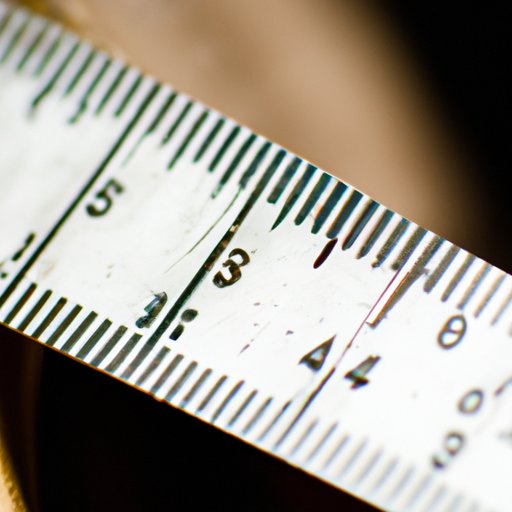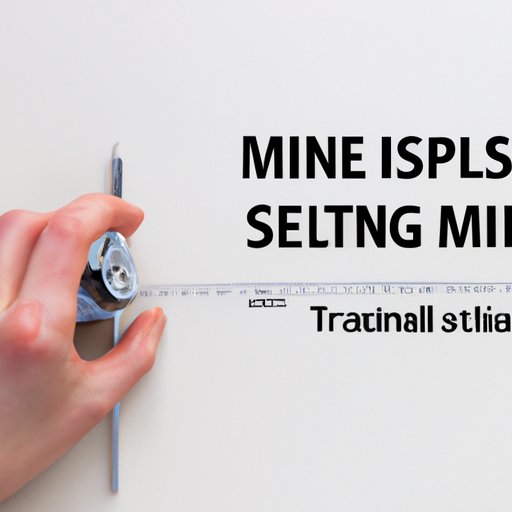
Introduction
Measuring in millimeters can be a tricky task, especially when accuracy is crucial. A millimeter is a very small unit of measurement, and even the slightest mistake can result in incorrect readings. Whether you’re a DIY enthusiast, a craftsman, or a professional in the industry, accurate measurements are important for ensuring the success of your project. In this article, we’ll explore the basics of measuring in millimeters, converting millimeters to inches, precision measuring devices and techniques, tips and tricks for improving accuracy, consistency in measurements, understanding the metric system, and how to avoid common millimeter measurement mistakes.
The Basics of Measuring in Millimeters: A Step-by-Step Guide
Millimeters are a unit of measurement in the metric system. They are equivalent to one-thousandth of a meter. The most important step in measuring in millimeters is to choose the right measuring tool according to the object being measured. The most common tools used for measuring in millimeters are rulers, calipers, and micrometers.
To measure in millimeters using a ruler, place the object to be measured against the ruler and align it with the zero-point mark. Read the measurement in millimeters on the ruler’s scale, taking into account any fractions of a millimeter between the markings.
Calipers are used to measure the distance between two opposing sides of an object. Place the object in between the caliper jaws and close it tightly. Read the measurement in millimeters on the caliper’s display, which may be digital or analog.
Micrometers are used for precise measurements of small objects. They have a spindle and an anvil to measure the thickness or diameter of an object. Place the object between the spindle and the anvil, turn the ratchet until the spindle is in contact with the object, and read the measurement in millimeters on the micrometer’s scale.
From Millimeters to Inches: How to Convert and Measure Accurately
There are instances when you need to convert measurements from millimeters to inches. For instance, if you’re working on a project that requires measurements in inches and you only have a ruler calibrated in millimeters, you need to be able to convert millimeters to inches accurately.
One inch is equivalent to 25.4 millimeters. To convert millimeters to inches, divide the measurement in millimeters by 25.4. For example, if the measurement is 50 millimeters, the equivalent measurement in inches is 1.97 inches.
It’s important to note that some measuring tools have both millimeter and inch scales. When using these tools, ensure that you’re measuring accurately in both units by checking and double-checking your measurements.
Measuring Devices and Techniques for Precise Millimeter Results
There are different types of measuring tools that can be used to measure accurately in millimeters. The most common ones are rulers, calipers, micrometers, and laser distance meters.
Rulers are the easiest and least expensive tool for measuring length in millimeters. They come in different lengths and widths and can be made of different materials such as plastic, wood or metal. Rulers are useful for measuring flat objects such as paper and fabrics.
Calipers are useful for measuring the thickness or the diameter of an object. They come in two types: digital and analog. Digital calipers are more accurate than analog ones, and they display the measurement on a digital screen. Analog calipers have a dial or a scale that shows the measurement.
Micrometers are used for accurate and precise measurements. They can measure to the nearest thousandth of a millimeter. They work by using a spindle and an anvil to measure the thickness or diameter of an object.
Laser distance meters are useful for measuring distances without having to touch the object being measured. They use a laser beam to measure the distance and display the measurement on a screen. Laser distance meters are useful for measuring distances in large rooms or outdoors.
When using any of these tools, it’s important to follow the manufacturer’s instructions for the specific tool to ensure accurate results. Additionally, ensure that the tools are calibrated and clean before use, as dirt or damage to the measuring tool can affect the accuracy of the measurement.

Enhancing Your Measuring Skills: Tips and Tricks for Millimeter Accuracy
Measuring accurately in millimeters requires practice, patience, and attention to detail. Here are some tips and tricks to help you improve your measuring skills:
– Use the right measuring tool for the object being measured.
– Use a magnifying glass or loupe to see the measurements more clearly.
– Hold the measuring tool at a right angle to the object being measured.
– Measure twice and compare the results to ensure accuracy.
– Use a stable surface to ensure the object being measured does not move during measurement.
– Record your measurements for future reference and comparison.
Additionally, there are some common mistakes to avoid when measuring in millimeters:
– Not using the right measuring tool for the object being measured
– Measuring at an angle
– Wrongly aligning the object being measured with the measuring tool
– Not taking into account any fractions of a millimeter between markings
The Importance of Consistency in Millimeter Measurements
Consistency is crucial in measuring in millimeters. Inconsistencies can arise due to the person taking the measurements, errors in the measuring tool or the object being measured. For consistency, it’s important to use the same measuring tool and ensure it’s calibrated and clean. Additionally, ensure that you’re measuring the same spot on the object being measured every time to ensure consistency.
Common causes of inconsistency in millimeter measurements include changes in temperature or humidity, dirt on the measuring tool, or the object being measured moving during measurement. To avoid these, ensure that you’re using a clean and stable surface, and that the measuring tool is clean and calibrated.
Understanding the Metric System: Measuring Length in Millimeters
The metric system is a decimal-based system of measurement that’s used throughout most of the world. It’s based on units of 10, and millimeters are part of this system. Understanding the metric system is important for accurate and consistent millimeter measurements.
Other common measurements in the metric system include centimeters, meters, and kilometers. One millimeter is equivalent to 0.1 centimeters, or 0.001 meters. One meter, on the other hand, is equivalent to 1,000 millimeters.
Common Millimeter Measurement Mistakes and How to Avoid Them
There are several common mistakes that people make when measuring in millimeters. Some of these mistakes include:
– Using the wrong measuring tool for the object being measured.
– Measuring at an angle.
– Incorrectly aligning the object being measured with the measuring tool.
– Not accounting for fractions of a millimeter between markings.
To avoid these mistakes, ensure that you’re using the right measuring tool for the object being measured. Hold the measuring tool at a right angle to the object being measured, and correctly align the object with the tool. Additionally, ensure that you take into account any fractions of a millimeter between the markings.
Conclusion
Measuring in millimeters accurately is crucial for the success of any project. Choosing the right measuring tool, converting millimeters to inches, using precise measuring devices and techniques, improving your measuring skills, maintaining consistency, understanding the metric system, and avoiding common millimeter measurement mistakes are keys to ensuring accurate measurements. By following the tips and techniques outlined in this article, you can measure in millimeters accurately and achieve the desired results in your project.




